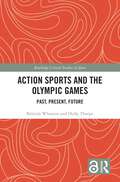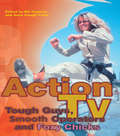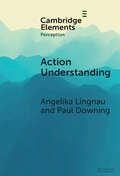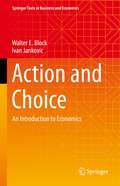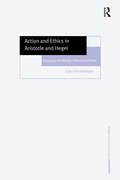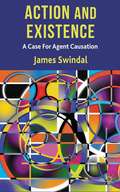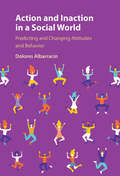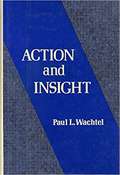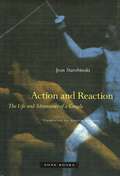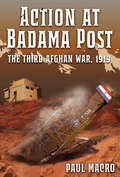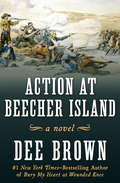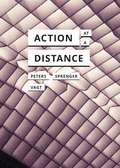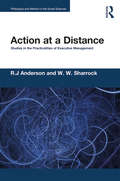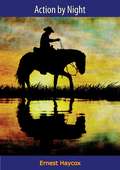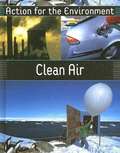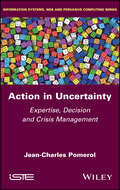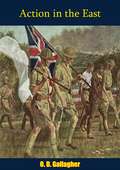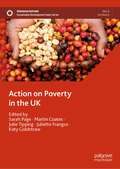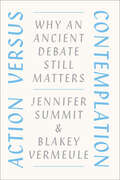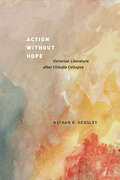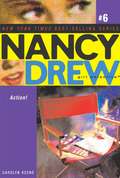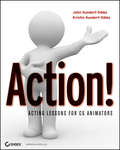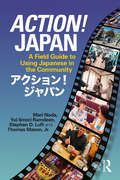- Table View
- List View
Action Sports and the Olympic Games: Past, Present, Future (Routledge Critical Studies in Sport)
by Belinda Wheaton Holly ThorpeBased on a decade of research by two leading action sports scholars, this book maps the relationship between action sports and the Olympic Movement, from the inclusion of the first action sports to those featuring for the first time in the Tokyo Olympic Games and beyond.In an effort to remain relevant to younger audiences, four new action sports, surfing, skateboarding, sport climbing, and BMX freestyle were included in the Tokyo Olympic program. Drawing upon interviews with Olympic insiders, as well as leaders, athletes, and participants in these action sports communities, the book details the impacts on the action sports industry and cultures, and offers national comparisons to show the uneven effects resulting from Olympic inclusion. It reveals the intricate workings of power and politics in contemporary sports organisations, and maps key trends in this changing sporting landscape.Action Sports and the Olympic Games is a fascinating read for anybody studying the Olympics, the sociology of sport, action sports, or sport policy.
Action TV: Tough-Guys, Smooth Operators and Foxy Chicks
by Anna Gough-Yates Bill OsgerbyFrom re-runs of 'TV classics' like The Avengers or Starsky and Hutch, to soundtracks, club nights and film remakes such as Mission Impossible II, the action series is enjoying a popular revival. Yet little attention has been paid to the history, nature and enduring appeal of the action series, and its place in popular culture, past and present.Action TV traces the development of the action series from its genesis in the 1950s. From The Saint to Knigh t Rider, contributors explore the key shows which defined the genre, addressing issues of audiences and consumption, gender and sexuality, fashion and popular culture. They examine the institutional and cultural factors influencing the action series, and relate shifts in the genre to other forms of popular culture including film, pop music, fashion and popular literature.Chapters include:* Of leather suits and kinky boots: The Avengers, style and popular culture* 'Who loves ya, baby?': Kojak, action and the great society*'A lone crusader in a dangerous world': heroics of science and technology in Knight Rider* Angels in chains? feminism, femininity and consumer culture in Charlie's Angels* 'Who's the cat that won't cop out?' Black masculinity in American action shows of the sixties and seventies
Action Understanding (Elements in Perception)
by Angelika Lingnau Paul DowningThe human ability to effortlessly understand the actions of other people has been the focus of research in cognitive neuroscience for decades. What have we learned about this ability, and what open questions remain? In this Element the authors address these questions by considering the kinds of information an observer may gain when viewing an action. A 'what, how, and why' framing organises evidence and theories about the representations that support classifying an action; how the way an action is performed supports observational learning and inferences about other people; and how an actor's intentions are inferred from her actions. Further evidence shows how brain systems support action understanding, from research inspired by 'mirror neurons' and related concepts. Understanding actions from vision is a multi-faceted process that serves many behavioural goals, and is served by diverse mechanisms and brain systems.
Action Whirligigs: 25 Easy-to-Do Projects
by Anders S. LundeWhirligigs -- those charming little wind-driven toys -- make excellent introductory woodworking projects because they are easy to do, inexpensive and -- most of all -- great fun! Hobbyists at all levels of ability will love creating the 25 delightful projects described in this book, from the simple Baking a Pie whirligig to the double-armed Woman at the Computer. Other figures include a Man/Woman Fishing, Oil Well Pump, Saluting the Flag, See-Saw, and Bucking Bronco. Easy-to-follow instructions and measured drawings explain everything from selecting and using proper tools and creating the driving mechanism to finishing and displaying the completed project.
Action and Choice: An Introduction to Economics (Springer Texts in Business and Economics)
by Walter E. Block Ivan JankovicThis textbook is based upon a philosophical method of logical deduction from basic principles such as scarcity, individual choice and subjectivism. This textbook attempts to show that all complex phenomena of economic theory such as prices of consumer goods and factors of production, saving and consumption, interest and profit, can be explained by the same primitive psychological principles of scarcity and substitution on the margin that could be used to describe economizing Robinson Crusoe on a desert island or two cavemen catching fish or exchanging apples for oranges. This textbook distils the essence of economic science prevailing in price theory before the 1930s, which the authors’ argue is superior to currently popular mainstream theory into a readable and student-friendly textbook format.This is an introductory textbook written in the tradition of Menger, Bohm-Bawerk, Mises and Hayek, instead in the tradition of Alfred Marshall and John Maynard Keynes, as almost all modern textbooks are. The authors offer a text not predicated on physics envy; on an attempt to liken economics to the physical sciences, on the basis of “empirical evidence”, statistics and verification.
Action and Ethics in Aristotle and Hegel: Escaping the Malign Influence of Kant (Ashgate New Critical Thinking in Philosophy)
by Gary PendleburyPendlebury alleges that abstraction and rationalization have had a strong and malign influence on normative moral philosophy in the 20th century. Criticizing writers such as Hare, Rawls and Scanlon for pursuing a conception of moral philosophy that bears little resemblance to the way in which human beings actually think and conduct themselves, Pendlebury, instead, suggests a ’Virtue Ethics’ inspired by Hegel’s and Aristotle’s accounts of action as a corrective to this trend, showing that moral activity is historically and socially based and must address the formed character of individual agents. This trend, which began with the responses by Locke, Hume and Kant to Descartes’ Meditations, rendered moral philosophy individualistic and psychologistic in contrast to Aristotle and Hegel’s claim that man is essentially a social creature. Pendlebury argues that this should be the starting point of any account and understanding of morality which roots the concept of will in the practical activity involved in being a member of an ethical community rather than an abstract metaphysical entity that is supposedly in the possession of individuals. In providing a critique of modern moral philosophy from this perspective, Pendlebury’s line of enquiry lends much support to ’Virtue Ethics’ as exemplified in the work of Hursthouse and Slote, while taking a more combative approach with those with whom he disputes. In doing so he shows that serious considerations of continental philosophy highlights the richness of moral activity absent from ’analytical’ tradition which for so long has been bent on marginalizing it.
Action and Existence
by James SwindalSince the pioneering work of Donald Davidson on action, many philosophers have taken critical stances on his causal account. This book criticizes Davidson's event-causal view of action, and offers instead an agent causal view both to describe what an action is and to set a framework for how actions are explained.
Action and Inaction in a Social World: Predicting and Changing Attitudes and Behavior
by Dolores AlbarracínThis book explains how actions and inactions arise and change in social contexts, including social media and face-to-face communication. Its multidisciplinary perspective covers research from psychology, communication, public health, business studies, and environmental sciences. The reader can use this cutting-edge approach to design and interpret effects of behavioral change interventions as well as replicate the materials and methods implemented to study them. The author provides an organized set of principles that take the reader from the formation of attitudes and goals, to the structure of action and inaction. It also reflects on how cognitive processes explain excesses of action while inaction persists elsewhere. This practical guide summarises the best practices persuasion and behavioral interventions to promote changes in health, consumer, and social behaviors.
Action and Insight
by Paul L. WachtelThe publication of this set of selected papers provides an opportunity to reflect on the compass of this work. It offers me, as well as the reader, the chance to reflect on the main themes and how they interact, and to consider the underlying as¬sumptions that have energized and, inevitably, limited the work. It affords as well a chance to consider the important questions that remain unanswered and how they might be pursued.
Action and Reaction: The Life and Adventures of a Couple
by Jean StarobinskiA wide-ranging, interdisciplinary conceptual history of the changing meanings and metaphors of &“action&” and &“reaction&” What is meant by reactionary politics? What do biologists mean when they speak of the interaction between life and its surroundings? Why was the term &“abreaction&” invented and later abandoned by the first generation of psychoanalysts? These are but a few of the questions the internationally renowned scholar Jean Starobinski answers in his latest work on the conceptual history of the words &“action&” and &“reaction.&”Not just a history of ideas, Action and Reaction is also a semantic and philological history, a literary history, a history of medicine, and a history of the biological sciences. Concentrating especially on the moment when scientific language and ordinary language diverge, the author offers a genealogy of the human and natural sciences through their usage of the metaphors action and reaction.Newton&’s theorem &“to every action an equal action is always opposed,&” stands as a point of departure for Starobinski&’s exploration of the lexical and metaphorical traces this proposition left in its wake. With stunning clarity, the author analyzes the scientific, literary, and political effects of the terms action / reaction in describing and explaining the material universe, the living body, the events of history, and psychological behavior.Ultimately, the book explores the power and danger of metaphorical language and questions the convergence and collapse of scientific and moral explanations of the universe.
Action at Badama Post: The Third Afghan War, 1919
by Paul MacroA thrilling account of the rescue of RAF crewmen after their aircraft crashes in Afghanistan in 1919. This is the story of an unknown incident during the little-known Third Afghan War. An aircraft from the No. 20 Squadron RAF was lost while investigating gathering tribesman. The crew were rescued, and most of the aircraft was recovered by the Kurram Militia and the 22nd Battery Motor Machine Gun Service. It was an all-arms action—the lives of two airmen were saved at the cost of an Indian Militiaman and an unknown number of Afghan tribesmen. It also illustrates the experience of a virtually unknown group of soldiers, the 22nd Battery of the Motor Machine Gun Service. They had volunteered to serve as Motor Machine Gunners in France, had been through an intense, competitive, and sometimes costly selection process, and had now suddenly found themselves dispatched half way round the globe to the heat, dust, snows and monsoons of India and the North-West Frontier. This book examines the conflict’s background, the Kurram Militia, the history of the squadron and the lives of the key players. While this was not the only action the 22nd Battery of the Motor Machine Gun Service fought during the Third Afghan War, this one was recorded in the account of A/Sjt Ernest “Bill” Macro, who was in charge of the section of 22nd Battery dispatched to Badama Post in late July 1919. This is his story, and the stories of the other men for whom the climax of their experience in the Third Afghan War came during the action at Badama Post
Action at Beecher Island: A Novel
by Dee BrownA gripping recreation of a notoriously bloody clash between US Army scouts and American Indian warriors, by the #1 New York Times–bestselling author. Historian Dee Brown dramatically recounts the nine-day siege between Plains tribes and Major James William Forsyth&’s scouts. Based on historical sources, the novel is told from a variety of viewpoints, including that of Lieutenant Frederick Beecher, still wounded from the Civil War and charged with clearing out American Indian settlements to make way for the Kansas Pacific Railroad. Beecher is joined by General Sheridan and Major Forsyth, as well as the scouts—from seasoned frontiersmen to young boys—employed to take part in the perilous mission. On the other side are the famous American Indian players in the battle: Turkey Leg and Roman Nose. With this complex assortment of characters, Brown vividly recreates the 1868 siege, as well as the competing worldviews of life on the prairies. This ebook features an illustrated biography of Dee Brown including rare photos from the author&’s personal collection.
Action at a Distance (In Search of Media)
by John Durham Peters Florian Sprenger Christina VagtHow are human actions shaped by the materiality of media? Contemporary media leads us more than ever to an &‘acting at a distance,&’ an acting entangled with the materiality of communication and the mediality of transmission. This book explores this crucial phenomenon thereby introducing urgent questions of human interaction, the binding and breaking of time and space, and the entanglement of the material and the immaterial. Three vivid inquiries deal with histories and theories of mediality and materiality: John Durham Peters looks at episodes of simultaneity and synchronization. Christina Vagt discusses the agency of computer models against the backdrop of aesthetic theories by Henri Bergson and Hans Blumenberg, and Florian Sprenger discusses early electrical transmissions through copper wire and the temporality of instantaneity.
Action at a Distance: Studies in the Practicalities of Executive Management (Philosophy and Method in the Social Sciences)
by R.J. Anderson W.W. SharrockThis book examines the nature of work and management, centring on documents as a class of management objects which have been relatively understudied in ethnomethodological research. Treating documents and similar artefacts as ordering devices, the authors describe consociation – the social organisation of patterns of coordinated action in situations where the usual resources of face to face communication are absent. With a focus on senior managers, this volume provides a description of the interior configuration of the world of senior management as the encountered, everyday experience of managing, drawing on first person experience rather than ethnographic fieldwork to shed new light on the importance of third person reflection upon practical understandings. An innovative study of the social character of such management objects as spreadsheets, strategic plans, computational models and charts, Action at a Distance will appeal to scholars of sociology with interests in ethnomethodology, the sociology of work and method in the social sciences.
Action by Night
by Ernest HaycoxACTION SPEAKS LOUDER...“Maybe I didn’t make myself plain to you,”Tracy Coleman said slowly.He flung the table aside and sent it crashing to the floor. George Pairvent rose and kicked away the chair; his hand went to his gun.Coleman came at him. He twisted Pairvent’s arm, pinning it back until he yelled and the gun dropped. Coleman knocked it aside with his foot, and dealt Pairvent a blow that sent him reeling against the bunks.He stepped back. “Have I made myself plain this time?”HORSEHEAD RANCHIt was a lush valley surrounded by mountains. And now it had been placed in the hands of Tracy Coleman, by an old man preparing to die. But others denied his claim, declaring Horsehead free range Cattle rustlers were in command when Tracy tried to take over, with fists and bullets matched in the deadly struggle for control.ERNEST HAYCOX, called “the supreme Western writer of all time” has masterfully recreated in this powerful novel the hair-trigger days of the Old West, as one man fights for justice and right.The famed Western novelist was the author of over forty books which have sold millions of copies in paperback, with many turned into highly popular films and adapted for TV.
Action for the Environment: Clean Air
by Rufus BellamyAction for the Environment. All around the world today, people are taking Action for the Environment. From small, local projects to large, global initiatives, people are finding ways to help prevent environmental damage. This new series helps build a foundation for a sustainable future by looking at: THE KEY ENVIRONMENTAL ISSUES, SOLUTIONS TO THE PROBLEMS, WHAT WE CAN DO TO HELP. Other titles in the series: Garbage Disposal, Water Supplies, Saving Wildlife, Energy Supplies, Transportation Solutions, Protecting Habitats, Food for All.
Action in Perception
by Alva Noë"Perception is not something that happens to us, or in us," writes Alva Noë. "It is something we do." In Action in Perception, Noë argues that perception and perceptual consciousness depend on capacities for action and thought -- that perception is a kind of thoughtful activity. Touch, not vision, should be our model for perception. Perception is not a process in the brain, but a kind of skillful activity of the body as a whole. We enact our perceptual experience.
Action in Uncertainty: Expertise, Decision and Crisis Management
by Jean-Charles PomerolDespite uncertainty, people are born to act. Faced with environmental aggression and upheaval, inaction is more stressful than action. What choices, strategies or methods need to be implemented so that action is as effective as possible in terms of the objectives to be achieved? We should not delude ourselves about the term "good decision", which does not have much meaning when we act in an uncertain environment and when we know the weakness of forecasts. However, we must know how to act and be capable of taking the most appropriate action. Action in Uncertainty is a real guide to taking effective action when nothing is certain. According to the different types of uncertainty, what are the respective good uses of expertise and intuition? How do we motivate teams and avoid cognitive bias and manipulation? These themes are dealt with in clear and accessible terms to help decision-makers make the right choices in a world that is more uncertain than ever.
Action in the East
by O. D. GallagherThis book, first published during WWII in 1942, is reporter O'Dowd Gallagher's account of nine eventful months in southeastern Asia. During his stay in Singapore, the Japanese bought to fruition their carefully conceived plan for striking simultaneously at Pearl Harbor, Malaya, Hong Kong, the Philippines, and the Netherlands Indies.An absorbing first-hand record of the brutal opening phases of the Second World War in the Far East.
Action on Poverty in the UK (Sustainable Development Goals Series)
by Sarah Page Katy Goldstraw Martin Coates Julie Tipping Juliette FrangosThis book tackles poverty and policy issues in the UK by discussing successful projects and practices, across lots of short chapters. The first section provides a brief history overview of poverty in the UK over the past two hundred years and discusses the question of why the UK, as a wealthy western nation, still has a poverty issue. It discusses various vulnerable groups and contextual factors which lead to these inequalities. The second section articulates what anti-poverty work is and shares project examples from across the country where anti-poverty workers are supporting people to survive and then to thrive. Lived experiences voices are articulated to present examples of poverty being experienced. This book draws on academic and practitioner work and aims to equip the activist and inform the student, academic and policy maker.
Action versus Contemplation: Why an Ancient Debate Still Matters
by Jennifer Summit Blakey Vermeule“All of humanity’s problems stem from man’s inability to sit quietly in a room alone,” Blaise Pascal wrote in 1654. But then there’s Walt Whitman, in 1856: “Whoever you are, come forth! Or man or woman come forth! / You must not stay sleeping and dallying there in the house.” It is truly an ancient debate: Is it better to be active or contemplative? To do or to think? To make an impact, or to understand the world more deeply? Aristotle argued for contemplation as the highest state of human flourishing. But it was through action that his student Alexander the Great conquered the known world. Which should we aim at? Centuries later, this argument underlies a surprising number of the questions we face in contemporary life. Should students study the humanities, or train for a job? Should adults work for money or for meaning? And in tumultuous times, should any of us sit on the sidelines, pondering great books, or throw ourselves into protests and petition drives? With Action versus Contemplation, Jennifer Summit and Blakey Vermeule address the question in a refreshingly unexpected way: by refusing to take sides. Rather, they argue for a rethinking of the very opposition. The active and the contemplative can—and should—be vibrantly alive in each of us, fused rather than sundered. Writing in a personable, accessible style, Summit and Vermeule guide readers through the long history of this debate from Plato to Pixar, drawing compelling connections to the questions and problems of today. Rather than playing one against the other, they argue, we can discover how the two can nourish, invigorate, and give meaning to each other, as they have for the many writers, artists, and thinkers, past and present, whose examples give the book its rich, lively texture of interplay and reference. This is not a self-help book. It won’t give you instructions on how to live your life. Instead, it will do something better: it will remind you of the richness of a life that embraces action and contemplation, company and solitude, living in the moment and planning for the future. Which is better? Readers of this book will discover the answer: both.
Action without Hope: Victorian Literature after Climate Collapse
by Nathan K. HensleyA study of how writers from the early phases of our prolonged climate emergency used aesthetic strategies to redefine the category of action. What does it feel like to live helplessly in a world that is coming undone? Nathan Hensley turns to Victorian literature to uncover a prehistory of this deeply contemporary sense of powerlessness. For many in nineteenth-century Britain, their world seemed so scarred by human rapacity that restoring it seemed beyond the powers of any one individual. Like George Eliot’s characters in Middlemarch or the doomed lovers of Wuthering Heights, observers of the gathering carbon economy felt themselves ensnared by interlocked and broken systems. In the face of damage so vast and apparently irreversible, what could possibly be done? To answer this question, Hensley shows that nineteenth-century writers and artists devised new ways to understand action—and hope. They rescaled action away from the grandly heroic and toward minor adjustments and collaborative interventions. They turned away from logical proofs and direct argumentation and instead called on aesthetic technologies like sonnets and fractured lyrics, watercolor sketches, and vast, multiplot novels, finding scope for action not at the level of the theme or the thesis but in gestures and details. Ranging from J. M. W. Turner’s painterly technique to Emily Brontë’s dreamlike fragments (and reading along the way works by Alfred, Lord Tennyson, H. G. Wells, Lewis Carroll, Gerard Manley Hopkins, William Berryman, Charlotte Brontë, George Eliot, and Christina Rossetti), Hensley’s study makes an important contribution to Victorian studies and the environmental humanities.
Action!
by Carolyn KeeneSo I agreed to play the part of Esther Rackham in a film about the heist that gave River Heights its name, and there was all this trouble on the set, and I figured out who was behind it. Case closed, right? Wrong! Once the camera starts rolling, a huge fire breaks out on the set, setting back production again. We're running out of time and funds. At least the fire turns up a key clue about who started it, but I'll have to continue juggling acting and sleuthing. Because it might be up to me to save this film from going up in flames....
Action!
by Kristin Kundert-Gibbs John Kundert-GibbsIn order to bring a character to life, it is beneficial for animators to have a solid understanding of acting principles, and this book examines the important skills behind the artistry of creating animated characters. With a particular emphasis on a character's motions and movement, this unique resource covers the basic elements of acting for CG animation and then progresses to more advanced topics such as internal intent and motivation.Note: CD-ROM/DVD and other supplementary materials are not included as part of eBook file.
Action! Japan: A Field Guide to Using Japanese in the Community
by Mari Noda Yui Iimori Ramdeen Stephen D. Luft Thomas Mason, Jr.Action! Japan is a practical guide for intermediate to advanced students of Japanese wanting to maximize their study abroad experience and enhance their language skills. This handy guide contains over 100 Field Performance tasks which prompt real-life interactions with native speakers. By carrying out these real-life tasks students refine and solidify existing communication skills and gain a fuller understanding of and participation in Japanese culture. The guide also provides over 60 Performance Watch tasks which help students understand how native speakers accomplish communicative goals through guided observation and analysis of naturally occurring interactions. Action! Japan helps students understand and participate socially in Japanese, guiding them through skill-getting and skill-using processes and enabling them to form meaningful connections with Japanese people in the community.
